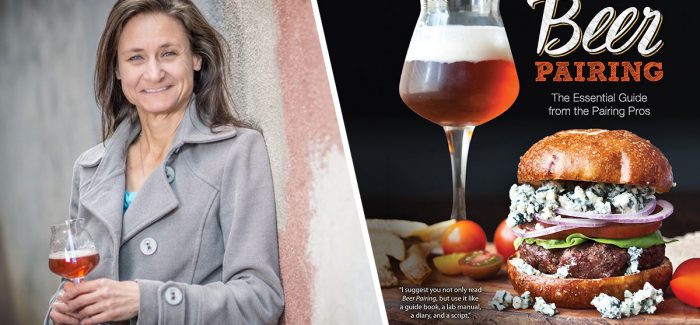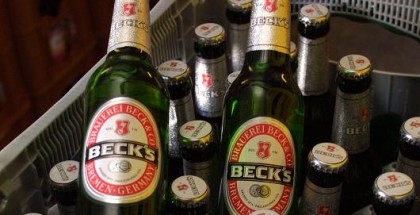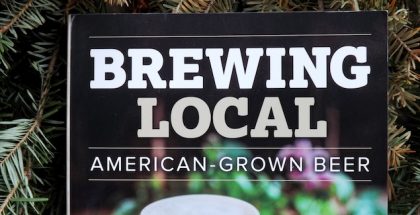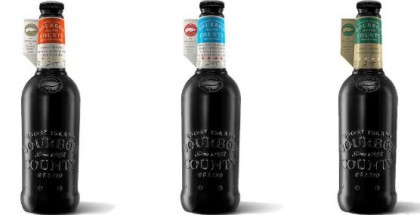Book Review & Interview | Beer Pairing
To those of us who love and know beer, it’s no secret that our favorite drink is awesome with food. Beer kills it with cheese; it crushes it with chocolate, and it’s never met a meat or vegetable it didn’t like. But while we’re all aware beer can pair beautifully with just about any dish, fine-tuning those pairings can prove an elusive feat, especially since everyone’s vocabulary for food and beer pairing seems to be different.
Beer Pairing: The Essential Guide from the Pairing Pros by Julia Herz & Gwen Conley (Voyageur Press, 2015)
Julia Herz, Craft Beer Program Director for the Brewers Association, recognized this same problem when she was designing the organization’s food and beer pairing program after taking over the position in 2007. Together with industry vet Gwen Conley, she wrote Beer Pairing: The Essential Guide from the Pairing Pros to bring together the disparate threads of beer and food pairing knowledge into one source that could guide drinkers, chefs, and brewers as they seek to understand the beautiful but complex interactions between food and beer.

Beer Pairing isn’t intended to be a handbook of specific pairings (such as Garrett Oliver’s venerated The Brewmaster’s Table), but rather unpacks the theory behind successful pairing practices, equipping the reader to plan their own combinations. Herz and Conley explain the basic principles of flavor interaction and provide exercises and tips on how to properly taste beer and food independently in order to pair them appropriately. After laying this foundation, there is a chapter that walks through a few dozen beer styles and provides examples and guidelines for pairing with them.
This book is an excellent guide for helping students of good beer think more critically about what goes into a good food pairing, making them better advocates for beer’s place at any table, no matter what foods are being served there.
I recently had the chance to talk on the phone with Julia about Beer Pairing, sensory science, and developing a pairing vocabulary.

David Nilsen for PorchDrinking: Tell me a little about your background in beer. How did this become such a big part of your life?
Julia Herz: When I was little, my dad would try to support my brother’s beer can collection by taking us to restaurants with an expanded beer list. That was no small task, because in those days there wasn’t the amazing beer revolution we know now. We would go to one place in D.C. that is no longer there called The Brickskeller. It had more than 500 different kinds of beer on the menu, all bottled or canned. So before I was 10, I was interested in beer and the fancy packages and labels and different flavors and colors, and watching my parents enjoy it responsibly. They also made sure that they tried it with food, so the food piece was always there from the start. I had always wanted to homebrew, and once I came of age at 21 I did start that. I also went on a cross-country trip and then said, “I want to work in brewing.” That was how it all pieced together.
My daughter is 10 and she tags along with my wife and I as well. She’s eagerly looking forward to being able to enjoy beer at some point.
Way to go, Dad! It’s a part of your life. You don’t hide it. You show it with appreciation and responsibility and then you have a kid who isn’t over-indulging and is hopefully enjoying it.
Exactly. So you’ve written Beer Pairing, as well as the Craftbeer.com Beer & Food Course. You mentioned seeing your parents always enjoying beer with food, but how did this become such a particular area of passion and knowledge for you in your career?
When I came into the BA as the Craft Beer Program Director, Ray Daniels, who started the Cicerone Program, left. I had to fill his shoes, and they were big shoes to fill. One of the concepts that came up again and again was beer and food pairing. I remember saying, “I know beer, but I am now being put in a situation where I have to talk with authority about beer and food and I know nothing about that.” I forced myself to learn and use that platform as an opportunity. If I had to speak with authority, I needed to feel that authority. I’ve worked with multiple amazing brewers and beer-minded chefs. I also targeted Gwen Conley to be my co-pilot and co-author for Beer Pairing because I wanted to take what I’d been learning and put it in a book for brewers and beer educators. I didn’t feel like that book existed, and now I feel like it does.

What have you been exploring recently with beer and food pairing?
It’s pretty geeky. We have a beer and food working group that I created from a group of my mentors. That group is Ray from the Cicerone Program, Randy Mosher, Dr. Nicole Garneau from the Denver Museum of Nature and Science, who is a doctor of genetics, Adam Dulye, executive chef for the Brewers Association, and then Pat Fahey, also of the Cicerone Program. Through my own journey in beer, I realized that the authorities I was looking to were all speaking about beer and food in a different way. So I didn’t start the group to standardize anything, but to get a handle on how we were articulating things and try to make sense of that. We have gathered over the course of three years about 600 palates in two very big tastings, and have started to research crowdsourcing the [sensory] information people are receiving. That research is not public yet, but we will be writing scientific papers on it backed by institutional review boards. What I’m [doing] today is not only teaching myself how to describe to others what I perceive so they can understand me, but also documenting scientifically what is happening with these interactions to make food more pleasurable because it was paired with beer.
That’s fantastic. I’m jealous that you have that group together!
It took some doing. They’re a busy bunch! But they’re all in and it’s super cool. We have a new beer and food pairing worksheet that we’re getting ready to launch. If you judge a beer, those score sheets have come along from different organizations over the years, and we now have a sheet that would allow you to taste-test a pairing that you might be putting on a menu. That sheet alone was a year and a half of work. I am super excited to get that a little more vetted and then have it free and available to anyone who wants to use it.
I’ll look forward to that. So that’s the cutting edge of food and beer pairing, but I know we’re still working to educate the public about the very basic idea that beer goes with food. We’re still working against some popular perceptions that favor wine for pairing. What would you say to a beginner as an elevator pitch to help them to see that beer is intended to be enjoyed with food and can pair so well with it?
First of all, we all know what we like. But there’s something called “hedonics” [that shows] the likability of things is skewed by our emotions and prior experiences. When you’re pairing or drinking or eating, shed your past. Shed your baggage against certain flavors. Open your palate and open your mind and you will find great discoveries.
When you wrote Beer Pairing, which came out in late 2015, that was just before a couple of current beer trends really hit big. I’m thinking of New England IPA and the emergence of fruited beers, especially fruited session sours like Gose and Berliner Weisse. Do you have any guidance for pairing principles with those beers?
We did mention Dogfish Head Festina Peche in the book. Any time you have acidity in the mix, it’s a game-changer and super fun to work with. And those fruity flavors can serve as bridges and hooks over to similar food flavors. So you’ve got the flavor and aromatics of the fruit, and then the components of acidity with the Berliner Weisse. We all know from pairing with wine that that does very well to calm the richness of food, and also lessens salt. So that’s going to happen any time you have beer with acidity in it. I like to say that like calms like, or like diminishes like. So if you have something acidic like ceviche, and then you have a Festina Peche, you could throw some peaches into that ceviche and sort of modernize it, and then you have bridges and hooks from the peaches and also the acid from the lemon in the ceviche to the lactic acid in the beer and you’ll really have brighter flavors because those two acidic components are going to negate each other.
You’re right that we have no reference for what we at the Brewers Association now refer to as Juicy or Hazy IPAs. We just released those guidelines, which is pretty unique. There’s three of them—Pale, IPA and Double IPA.
Juicy or Hazy IPAs are a complex one. Going back to the Berliner Weisse, I didn’t even get into any aspects of the fruit and the mouthfeel. But one of my favorite things about juicy or hazy beers is the mouthfeel component. Hops have a low protein component, believe it or not. And hops have definite contributions to tannins and polyphenols. So the same way that wine will be grippy from the grape skins, beer can be tannic or grippy from fruit skins, or different kinds of hops and malts, which can contribute tannins. So the hops in Juicy or Hazy really bring not just the murkiness and the weight and the extra body mouthfeel to that beer, which to me lessens the alcohol and makes it a little smoother and sneakier, but it also brings those tannins. Tannins do a great job of matching up with basic taste elements in food. Most of the time in these beers you’ve got American-style hops. I like to group those—we talk about this in the book—into two main categories I call the Tropics and the Forest. So that might be pith of grapefruit to clementines or tangerines, and then you work your way to the forest and you get juniper, spruce tips, pine. If you’re working with the Juicy or Hazy IPA, you want to figure out which type of hop flavors and aromatics you’re working with, and then a great way to find harmony or echoes is to use similar types of herbs or spices in the food that would marry over and bridge to those hop flavors.

For most of us, when we look back at how we got started in craft beer, there’s usually that first beer we had that opened our eyes to what beer could be. I find with beer and food pairing, there’s usually that similar “aha” moment where you had that perfect combination. Do you have a memory like that of the first time you had a beer and a food together that made you say, “Wow, this is awesome”?
I love fettuccine alfredo. It’s this naughty, amazing dish. Fettuccine has lots of rich parmesan, which also has umami, and also brings to the table fat and salt. Lots of really good basic tastes to work with there. Cream brings more richness to the dish. And then you can sprinkle rosemary and sage lightly on top. So there you’ve got herbal components working their way to the forest notes of American hops, or English hops, which can be more earthy. You could do an English Old Ale, or an Ordinary Bitter, or an American Pale Ale, all the way to an American IPA. Lots of really great matches. So that’s a great one, and an “aha” for sure. If you spice up the fettuccine, the sweetness of the beer is going to calm that capsaicin and let you taste more of what’s in the actual hot sauce.
You’re from the Denver area, right? What beers from that area have you been enjoying lately?
I always try to make sure I have some locals and some regionals, and I’ll get mix-sixers or variety packs. So at home right now in the fridge we have the Deschutes variety pack, which is fun. I was in Vermont recently and brought back some beers, and the von Trapp Brewery blew me away. I had Alchemist Heady Topper while I was there. We also are always trying to figure out who has what around here. I was at Joyride Brewing recently, who are amazing. Edgewater, right outside of Denver. They are all about being in the moment. Their logo is an elephant that’s upside-down riding a bicycle, like, “better be in the moment and enjoy the ride.” They had a beer that blew me away, and I have a crowler of it in my fridge for this weekend. It’s a saison with 24% spelt and brettanomyces. It’s firing on all cylinders. It’s got a little different malt base note because of the spelt. The barnyard flavors aren’t so much there, it’s more pineapple notes from the brettanomyces claussenii, which is the more tropical brett as opposed to more barnyard. Super fun beer that I just had to get a crowler of.
That sounds fantastic. I’m jealous I can’t get it here!
They’re worth visiting!








Submit a Comment